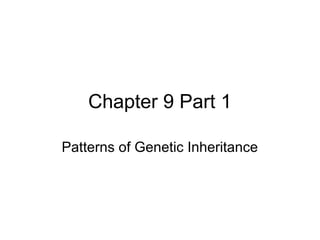
Bio 100 Chapter 9 part 1
- 1. Chapter 9 Part 1 Patterns of Genetic Inheritance
- 2. Gregor Mendel Deduced Laws of Inheritance A blended model of inheritance existed prior to Mendel • Before the science of inheritance was fully understood, breeders understood that parents contributed equally to offspring, but believed it was due to blending. • Ex. When red and white flowers breed, pink flowers result and when red or white would reappear later, it was due to genetic instability. • Gregor Mendel - an Austrian monk that did extensive pea plant research starting in the 1860s.
- 3. Mendel designed his experiments well • Garden pea – Easy to cultivate – Short generation time – Produce many offspring – Normally self-fertilize, resulting in individuals that look like the parent (true breeding)
- 5. • Mendel’s design – Removed anthers to prevent self-fertilization – Dusted carpel with pollen from a plant with a different characteristic – Carpel developed into a pod containing peas – Only one characteristic resulted – If those were bred together (F2 generation) both characteristics can be found again – Mendel chose easy to identify traits • Flower color, seed color, seed shape
- 6. Single-trait crosses reveal units of inheritance and the law of segregation Mendel’s law of segregation describes how gametes pass on traits • Ensured true breeding (offspring always looked like parents) and then performed cross-fertilization experiments • With previous thinking, breeding these two together should result in an intermediate, but that is not what happened.
- 7. • P generation – original parents • F1 generation – first batch of offspring • F2 generation – offspring of F1 parents (self-fertilization) • When he crossed tall and short plants, all offspring were tall. • When he allowed F1 generation to self-fertilize, 75% were tall and 25% were short, so although F1 did not express that trait (short), it was still able to pass it on to future generations.
- 8. • The results led him to the conclusion that the parents contained two separate copies of each hereditary factor, one dominant and one recessive. • Monohybrid crosses – examining only one trait • Law of segregation – Each individual has two factors for each trait – The factors segregate (separate) during the formation of the gametes – Each gamete contains only one factor from each pair of factors – Fertilization gives each new individual two factors for each trait
- 9. The units of inheritance are alleles of genes • Alleles – alternative forms of a gene • Gene locus – location of an allele on a chromosome • Dominant allele – masks expression of the other allele (capital letter) • Recessive allele – dominant allele masks the expression of this one (lowercase letter) Dominant does no mean normal or most frequent Through meiosis, only one allele for each trait is in each gamete
- 10. • Homozygous – organism has two identical allele (homozygous dominant or homozygous recessive) • Heterozygous – two different alleles – dominant allele expressed • Genotype – alleles the individual has • Phenotype – physical appearance • Linkage group – grouping of alleles on a chromosome that will be inherited together (comes into play when looking at inheritance of multiple traits)
- 11. Two-trait crosses support the law of independent assortment Mendel’s law of independent assortment describes inheritance at multiple traits • Dihybrid cross – two traits are examined • Two possible results when crossing tall with green pods and short with yellow pods – If the dominant alleles always stay together and the recessive alleles always stay together, then 2 phenotypes will result in F2 plants (tall with green pods and short with yellows pods) – If the 4 factors segregate, 4 phenotypes will result • Tall with green pods, tall with yellow pods, short with green pods, short with yellow pods • Mendel found 4 phenotypes (phenotypic ratio 9:3:3:1)
- 12. • Law of independent assortment – Each pair of factors separates (assorts) independently (without regard to how the others separate) – All possible combinations of factors can occur in gametes • If alleles are not linked, traits will follow this law
- 13. • What are the possible genotypes of a tall pea plant with green pods?
- 14. Mendel’s results are consistent with the rules of probability • Punnett square – Diagram used to calculate results of a cross – Can be used to determine probability of offspring inheriting a specific trait • In humans, freckles is dominant over no freckles. A man with freckles reproduces with a woman with freckles, but their children have no freckles. What chance did each child have for freckles?
- 15. Testcrosses support Mendel’s laws and indicate the genotype One trait test cross • To confirm F1 were heterozygous, they were crossed with homozygous recessive. Half should express one phenotype, the other half the other phenotype (1:1 phenotypic ratio) • Test crosses can determine if genotype is heterozygous or homozygous dominant
- 16. Two trait testcross • To determine genotype when a dominant trait is expressed, it is crossed with one that is homozygous recessive for both traits. • If homozygous dominant for both traits, only the dominant phenotypes will be expressed for both when crossed. • If heterozygous for one or both traits, recessive phenotypes will be expressed after cross.